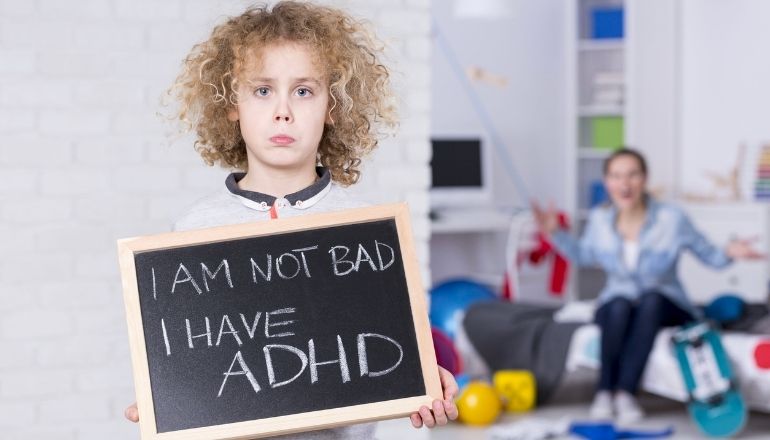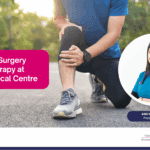Author : Dr.Sihab (Specialist Pediatrician)
Attention Deficit Hyperactive Disorder (ADHD) is one of the most common childhood disorders and can continue through adolescence and adulthood for some. ADHD is a neurobehavioral disorder characterized by significant difficulties of inattention, hyperactivity, and impulsiveness or a combination of the two. Kids with ADHD act without thinking are hyperactive and have trouble focusing. They may understand what’s expected of them but have trouble following through because they can’t sit still, pay attention or attend to details. Of course, all kids (especially younger ones) act this way at times particularly when they are anxious or excited. But the difference with ADHD is that symptoms are present over a longer period and occur in different settings. They impair a child’s ability to function socially, academically and at home. Sometimes ADHD is not recognized during childhood, and they are diagnosed later as an adult. (The good news is that with proper treatment kids with ADHD can learn to successfully live with and manage their symptoms).
Treatment of ADHD is not just taking medications. There is no cure for ATTENTION DEFICIT HYPERACTIVE DISORDER (ADHD), but treatment can alleviate your child’s symptoms and make the condition much less of a problem in day-to-day life.
How common is ADHD?
It is difficult to say exactly how many children worldwide have ADHD because different countries have used different ways of diagnosing it, while some do not diagnose it at all. In the U.K, diagnosis is based on quite a narrow set of symptoms and about 0.5 -1% of children are thought to have attention or hyperactivity problems. In comparison until recently, professionals in the U.S used a much broader definition of the term ADHD. As a result, up to 10% of children in the US were identified as having ADHD. Current estimates suggest that ADHD is present throughout the world in about 1 to 5% of the population. About 5 times more boys than girls are diagnosed with ADHD. This may be partly because of the particular ways they express their difficulties. Boys and girls both have attention problems, but boys are more likely to be overactive and difficult to manage. Children from all cultures and social groups are diagnosed with ADHD. However, children from certain backgrounds may be particularly likely to be diagnosed with ADHD, because of different expectations about how they should behave. It is therefore important to ensure that, a child’s cultural background is understood and taken into account as a part of the assessment.

What causes ADHD?
The exact cause of ADHD is unknown, so parents should not blame themselves for these problems. Many factors likely play a role in each case of ADHD, very little of which has to do with specific parenting or child-rearing skills. Inevitably parents will ask themselves “What did I do to cause this?” or “How could I have prevented it?” but most of the evidence points to genetic factors, environmental factors or brain damage. Instead, parents should focus on how best to help their child with ADHD.
Possible causes of ADHD
1.Genes
ADHD has a strong genetic basis in the majority of cases (in about 75% of all cases a child with ADHD is four times as likely to have a relative who had similar complaints or who had been diagnosed with a similar condition). Two dopamine genes, DAT1 & DRD4 have been reported to be associated with ADHD. People with ADHD seem to have lower levels of dopamine in the brain. Children with ADHD who carry a particular version of the gene have thinner brain tissue in the area of the brain associated with attention. Research into this gene has shown that the differences are not permanent. As children with this gene grow up, the brain develops to the normal thickness and most of the symptoms subside.
2.Nutrition and Food
Food additives and sugar
- Food additives are believed to exacerbate ADHD
- Sugar – older studies did suggest that there is a strong link for abnormal behavior but recent researches does not show a link between ADHD and sugar. While the jury is still out on whether sugar can contribute to ADHD symptoms, most experts now believe that the link is not a strong one.
- Decreased intake of Omega 3 fatty acids:-
- Studies suggest that a lack of omega 3 fatty acids is linked to ADHD symptoms. Fish oil supplements appear to alleviate ADHD symptoms, at least in some children, and may even boost their performance at school.
3.Environment
- There may be a link between ADHD and maternal smoking, and alcohol intake during pregnancy. Nicotine can cause hypoxia (lack of oxygen) in Utero.
- Lead exposure has also been suggested as a contribution to ADHD which can sometimes be found in plumbing, pictures or paint in old buildings.
4.Brain function and structure
Studies involving brain scans have suggested that certain areas of the brain may be smaller in people with ADHD, whereas other areas may be larger.
5.Executive function
Cognitive processes that regulate, control, and manage other cognitive processes are termed ‘executive functions’. Example: planning, attention, inhibition, and working memory like regulated processes. One of the theories of ADHD suggests symptoms arise from a primary deficit in executive functions. ‘EF weaknesses are neither necessary nor sufficient to cause all cases of ADHD’.
6.Evolution
At more than 1% of the population, researchers have proposed that the high prevalence of ADHD may be due to the natural selection of traits favoring ADHD, possibly because the individual traits may be beneficial on their own and only become dysfunctional when these traits combine to form ADHD. The high prevalence of ADHD may in part be because women, in general, are more attracted to males who are risk-takers, there by promoting ADHD in the gene pool. Recent studies suggest that ADHD is more common in children whose mothers are anxious or stressed in priming the child with the necessary traits for a stressful or dangerous environment in turn leading to increased impulsivity, explorative behavior etc.
Other causes
Other causes would be a traumatic brain injury, very low birth weight, and extremely premature birth.
Social
Researchers have found behaviors typical of ADHD in children who have suffered violence and emotional abuse.
Heredity
Heredity is the most common cause of ADHD. Most of our information about the heredity of ADHD comes from family studies, adoption studies, twin studies and molecular genetic research.
- Adoption Studies: Studies conducted on adoptive children with hyperactivity to their adoptive and biological parents revealed that hyperactive children resembled their biological parents more than they did their adoptive parents.
- Twins studies: Studies report 82% concordance rate for ADHD in identical twins as compared to a 38% concordance rate in non-identical twins.
Core Features
- Inattention (9 symptoms)
- Hyper Activity (7 symptoms)
- Impulsivity
- (4 symptoms)
- INATTENTION CLUSTER :
- Cannot sustain attention, premature withdrawal of attention ‘distraction’
- Careless
- mistakes in school or other work
- Seems not to lesson when spoken to directly
- Does not follow through on instructions and fails to finish schoolwork
- Difficulty in organizing chores, tasks, and activities
- Avoid tasks that need sustained mental effort (e.g. homework)
- Often loses articles needed for task (e.g. toys, pencils, books )
- Easily distracted.
- Forgetful of daily activities.
HYPERACTIVITY CLUSTER:
- Fidgets with hands/feet, squirms in seat
- Leaves seat in class or were seating in norm
- Runs about/climbs inappropriately
- Difficulty playing quietly
- Talks excessively/unthinking breach of rules
- Continuously ‘On the Go’ as if ‘driven by a motor
- Dashes around touching or playing with anything and everything in sight
IMPULSIVITY CLUSTER:
- Blurts out answers before questions have been completed
- Often has difficulty awaiting turn
- Often interrupts or intrudes on others (Butts into conversation or games)
- Very impatient
How to diagnose ADHD:
DSM-IV-TR (The American psychiatric association and statistical manual IV text review)
As per this criterion:
1. Either A or B
A: Six or more of the following symptoms of inattention have been present for at least 6 months to an extent that is inappropriate for developmental level (symptoms as mentioned above).
B: Six or more of the following symptoms of hyperactivity-impulsivity have been present for at least 6 months to an extent that is disruptive and inappropriate for developmental level (symptoms as mentioned above)
2. Some symptoms that cause impairment were present before age of 7 years.
3. Some impairment from the symptoms is present in two or more settings. (e.g. at school, work and at home )
4. There must be clear evidence of clinically significant impairment in school, social or work functioning.
5. The symptoms are not better accounted for by another mental disorder (mood disorders, anxiety disorders, dissociative disorders, or personality disorders)
Types of ADHD: Identified by American Psychiatric association
- ADHD combined type: – Both inattention and hyperactivity-impulsivity symptoms.
- ADHD is predominantly inattentive type:- Inattention but not enough hyperactivity-impulsivity symptoms.
- ADHD predominantly hyperactivity and impulsivity type: Hyperactivity – impulsivity but not enough inattention symptoms.
How to manage ADHD
Treatment of ADHD is not just taking medications. There is no cure for ATTENTION DEFICIT HYPERACTIVE DISORDER (ADHD), but treatment can alleviate your child’s symptoms and make the condition much less of a problem in day-to-day life.
ADHD can be treated using psychosocial treatments or pharmacotherapy, but it is widely agreed a combination of both is the best way to treat it.
Psychosocial treatments:
Behavioral therapy:
This provides support for cases of children with ADHD and may involve teachers as well as parents. Behavioral therapy usually involves behavior management, which uses a system of rewards and penalties to encourage your child to try and control their ADHD.
If your child has ADHD, you can identify the types of behavior you want to encourage, such as sitting at the table to eat. Your child is then given a small reward for good behavior or a small penalty for poor behavior. For teachers, it involves learning how to plan and structure activities, and to praise and encourage children for every progress.
Whether or not a child is taking medication, behavior therapy may help improve your relationship with your child.
Parent Training and Education Program:
It helps you learn specific ways of talking to your child, playing with them etc to improve their attention and behavior.
Social Skills Training:
This involves your child taking part in role-play situations and aims to teach them how to behave in social situations.
Cognitive Behavioral Therapy:
Is an alternative form of therapy based on the idea that your problems are created by you. It is not that the situation itself is causing the problem but it is about how you think about it and how you react to it.
This therapy is to change how your child feels about a situation, which would in turn change their behavior.
Other Methods of Treatment:
There are other ways of treating ADHD that some people find helpful such as cutting out certain foods, and taking supplements.
FOOD items considered to worsen ADHD:
- Sugar, Caffeine, Food Preservatives, Wheat, Diary products. People with ADHD should eat a Healthy Balanced Diet. Do not cut out foods without medical advice.
SUPPLEMENTS considered to improve ADHD:
- Omega 3 Fatty Acids (cod liver oil)
- EXERCISE: Regular exercises are recommended for children with ADHD.
Pharmacotherapy:
Types of Medicines:
- Methylphenidate – CNS stimulant
- Dexamfetamine,lisdexamfetamine– CNS stimulant
- Atomoxetine – Noradrenaline uptake inhibitor
- Guanfacine- improves attention, should not be offered to adults with ADHD
Medications help someone who has ADHD to:
- Concentrate better
- Be less impulsive
- Feel calmer
- Learn and practice new skills
- Medications are most effective if used every day.
Treatment breaks are not normally recommended. Generally, children with ADHD will need to continue treatment at least until after higher secondary school examinations.
Side Effects:
Side effects are negligible, abdominal pain, nausea, dizziness, appetite loss, irritability, increase in blood pressure etc.
Medication treatment is more effective when combined with psychosocial therapies. ADHD medications should be closely monitored.
Differential diagnosis of ADHD:
Medical and Psychosocial:
Medical: Hypothyroidism, anemia, lead poisoning, hearing and vision impairments, substance abuse, child abuse.
Psychosocial: sleep disorders like sleep deprivation, obstructive sleep apnea, narcolepsy, and delayed sleep phase syndrome.
Persistence into adulthood:
Every day we see adults with ADHD.
60% of children with ADHD carry the disorder into adulthood.
85% of adults with ADHD are not diagnosed.
This article is written by Dr.Sihab P ( Specialist Pediatrician – WELLKINS Medical Centre)







